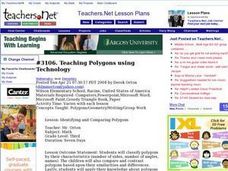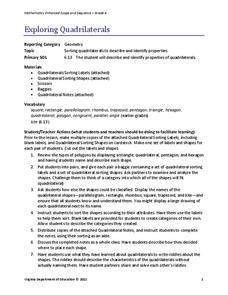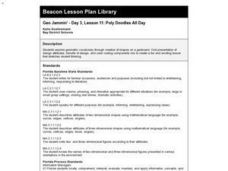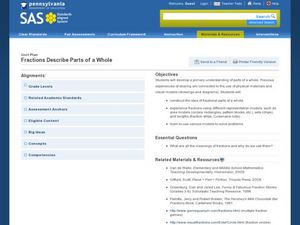Curated OER
Can You Name That Shape?
Learners use materials to build, investigate, and draw two-dimensional shapes (polygons). They combine the shapes they have built and draw from the pile to begin a round-robin activity to name and determine the attributes of a selection...
Curated OER
Shape Sort
Sorting is a great way to familiarize learners with basic shapes in this partner activity. Pairs have sixteen shape cards with various sizes and types of triangles, rectangles, hexagons, and squares. They have four category cards in...
Curated OER
Classifying Polygons
Seventh graders participate in a polygon hunt. In this polygon lesson, 7th graders examine how polygons are alike and different. Students create a Venn diagram and label the sorting circles. Students work in cooperative groups to sort...
Curated OER
Polygon People
Students identify polygons. In this polygon people lesson, students draw required shapes and construct a polygon person. They identify each shape and its characteristics. The lesson may be extended by allowing students to explore the...
Utah Education Network (UEN)
Create, Classify, and Sort Quadrilaterals
Quadrilaterals can be quirky! Fourth graders use geoboards and bands to create four-sided figures. They analyze the attributes such as angle size and presence of parallel sides. As a result they learn to differentiate among rectangles,...
Curated OER
Teaching Polygons using Technology
Third graders utilize different types of computer programs, such as Microsoft paint and Microsoft Word to study and create different types of polygons. They use PowerPoint to create a story about a shape and others that it meets during a...
Virginia Department of Education
Exploring Quadrilaterals
Sort this resource into the Use pile. Scholars investigate attributes of quadrilaterals and then use the results to sort and classify the shapes labeling each figure with their properties to justify the classifications.
Curated OER
Regular Polygons
Fifth graders explore polygons. In this math lesson, 5th graders find examples of regular polygons in the classroom and measure the sides of figures to determine if they are regular polygons.
Curated OER
Polygons Defined
Fourth graders explore polygons. In this polygon lesson, 4th graders sort polygons according to their properties. Students discover the connection between polygons and the Greek language.
Curated OER
Quadrilaterals
Students create, classify and sort quadrilaterals. They create several four-sided polygons, then choose their most unique quadrilateral to share with their group.
Curated OER
The Greedy Triangle-Intro to Geometric Shapes
In this geometry lesson, learners read The Greedy Triangle and use geoboards to construct geometric shapes. They identify the number of sides and angles each shape has.
Curated OER
Introducing Angles
Sixth graders identify, compare and interpret the characteristics of polygons and angles in order to meet spatial sense, geometry and measurement standards. They also sort shapes into three categories, polygons (regular and irregular)...
Curated OER
Magician Squares
Elementary school learners investigate the attributes of a square. They discover that squares are polygons and examine squares found in everyday life. They concentrate on connecting the word, square, with the shape. As an extension,maybe...
K-5 Math Teaching Resources
2-D Shape Cards
Add some visual support to your elementary geometry lessons with this set of printable shape cards. From triangles and squares to octagons and nanogons, this simple resource can be used in countless ways to develop children's knowledge...
Alabama Learning Exchange
Twisted Tangrams
Primary geometers create a picture using tangrams. In this geometry lesson, students read Grandfather Tang: A Tale Told with Tangrams, cut out their own tangrams, and choose a character from the story to make using their tangram pieces.
Curated OER
I. M. Pei and the Geometry of the NGA
Students compare design elements in neoclassical and modern architecture. They review knowledge of triangles and quadrilaterals and design a geometric pattern using Pei's polygons They create a city plan using a variety of lines and...
Curated OER
It's a 3-D World Out There!
Students construct polygons. They identify attributes of three-dimensional shapes. Students name common three-dimensional shapes. They draw three-dimensional shapes, and sort three-dimensional shapes. Students use K'NEX materials sets to...
Curated OER
1st Geometry
In this geometry worksheet, learners choose the multiple choice answer to 15 questions involving several different elements of geometry.
Curated OER
Tri this Angle!
First graders draw and describe various types of polygons. they investigate their own environments for examples of polygons. After reading the book, The Greedy Triangle, they discuss everyday objects that are polygons. They create shape...
Curated OER
Geo Jammin' - Day 3, Lesson 11: Poly Doodles All Day
Learners explore geometric vocabulary through creation of shapes on a geoboard. They present design attributes, transfer of design, and color-coding components mix to create a fun and exciting lesson that stretches student thinking.
Curated OER
Fractions Describe Parts of a Whole
Third graders represent fractions as part of a whole. In this fractions lesson, 3rd graders use manipulatives to show how a fraction is a part of a whole. This lesson includes individual practice and an assessment instead of direct...






















